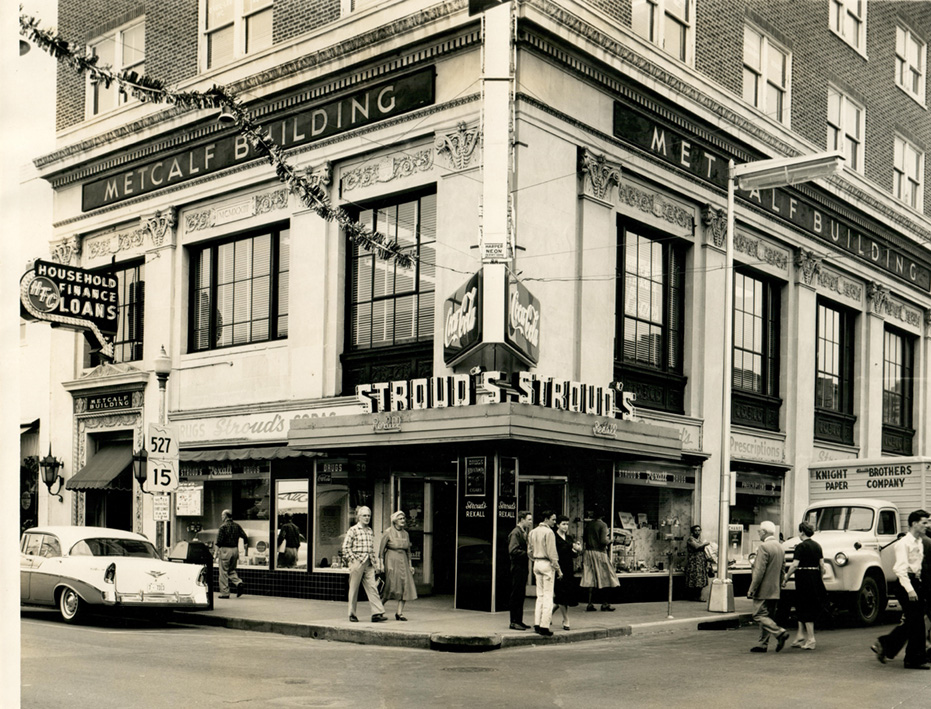
Stroud’s Rexall Drugstore was located on the corner of Orange Avenue and Church Street in the 1950s. This was the site of the sit-in demonstration by eleven Black students on March 9, 1962.
By Whitney Barrett, History Center Archivist
“For an appetizing meal or snack, visit a Woolworth’s lunch department.” In the 1950s, this was a familiar advertisement readers would see in their daily newspapers. However, though not specified, it was understood that the invitation to enjoy a meal or snack at the popular five-and-dime chain did not extend to everybody in the South. In 1960, four Black students from North Carolina A&T State College were refused service at an all-white Woolworth’s lunch counter in Greensboro, North Carolina, because of their race. When asked to leave, they refused, and their sit-in demonstration sparked a nationwide protest that would be felt in segregated spaces all over the country – even to downtown Orlando.
Although many sit-ins across the South were organized by college students, in Orlando the main organizers were high school students who belonged to groups such as the Liberal Religious Youth and the NAACP Youth Council. These teenagers were supported by well-respected Black community leaders, including the Rev. Nelson Pinder. After several successful boycott protests at the Big Apple City Market, Winn-Dixie, and Publix, the students’ campaign to fight segregation made its way downtown.
On March 5, 1960, young Black Orlandoans carried out two demonstrations simultaneously. Around 11:30 a.m., six youths entered the S. H. Kress Co. store at 122 S. Orange Ave., and six others entered F. W. Woolworth Co. directly across the street. Both groups quietly sat on stools at the lunch counters but were denied service. Kress and Woolworth personnel chose to close their stores when the demonstrators arrived and took their seats. Both demonstrations were carried out without violence.
Several days later, on March 9, about 35 students went back to the Kress and Woolworth stores and also to McCrory’s, another Orange Avenue five-and-dime with a lunch counter, to again protest theses businesses’ segregationist practices. Again, the lunch counters were closed upon the students’ arrival and reopened shortly after they left.
Demonstrations continued until September, when, in an effort to avoid the violence and unrest taking place in Florida cities such as Tampa and Jacksonville, some downtown Orlando merchants agreed to open their lunch counters to Black patrons during prearranged hours. This decision was not well received by the city’s White Citizens’ Council, which threatened to boycott the stores that implemented this policy. Nonetheless, the agreement went into effect. Although this was a step toward equality, progress was slow, and Black residents continued their efforts to desegregate downtown businesses.
On March 9, 1962, eleven Black students were arrested on charges of disorderly conduct for simply refusing to vacate the white lunch counter during a peaceful sit-in demonstration at Stroud’s Rexall Drugstore, next to the Kress store at Orange Avenue and Church Street. The students spent that night in jail and were held on bail of $250 each. The Black community gathered the money for the students to be released the following morning.
It was clear from the persistent actions of these students that they were not content to stay on the sidelines in this fight. Their pursuit of equality proved to be effective when on June 6, 1963, Orlando Mayor Bob Carr announced during a speech that chain and drugstore lunch counters in downtown were to be integrated, as well as some other public spaces. This sit-in movement, although small compared with some other cities, was instrumental in paving the way for future civil rights victories in Orlando.

